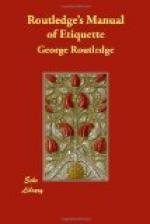Figurez devant, dance before.
Figurez a droite—a gauche, dance to the right—to the left.
La grande tour de rond, all join hands and dance, completely round the figure in a circle back to places.
Le grand rond, all join hands, and advance and
retreat twice, as in
La Finale.
Le grand quatre, all eight couples form into squares.
La grande chaine, all the couples move quite round the figure, giving alternately the right and left hand to each in succession, beginning with the right, until all have regained their places, as in last figure of the Lancers.
La grande promenade, all eight (or more) couples promenade all round the figure back to places.
La main, the hand.
La meme pour les cavaliers, gentlemen do the same.
Le moulinet, hands across. The figure will explain whether it is the gentlemen, or the ladies, or both, who are to perform it.
Pas d’Allemande, the gentleman turns his partner under each arm in succession.
Pas de Basque, a kind of sliding step forward, performed with both feet alternately in quick succession. Used in the Redowa and other dances. Comes from the South of France.
Glissade, a sliding step.
Le Tiroir, first couple cross with hands joined to opposite couple’s place, opposite couple crossing separately outside them; then cross back to places, same figure reversed.
Tour des mains, give both hands to partner, and turn her round without quitting your places.
Tour sur place, the same.
Tournez vos dames, the same.
Tour aux coins, turn at the corners, as in the Caledonians, each gentleman turning the lady who stands nearest his left hand, and immediately returning to his own place.
Traversez, cross over to opposite place
Retraversez, cross back again.
Traversez deux, en dormant la main droite, lady and vis-a-vis gentleman cross, giving right hand, as in La Poule.
Vis-a-vis, opposite.
Figure en tournant, circular figure.
Etiquette of Courtship and Matrimony
* * * * *
I.—FIRST STEPS IN COURTSHIP.
It would be out of place in these pages to grapple with a subject so large as that of Love in its varied phases: a theme that must be left to poets, novelists, and moralists to dilate upon. It is sufficient for our purpose to recognize the existence of this the most universal—the most powerful—of human passions, when venturing to offer our counsel and guidance to those of both sexes who, under its promptings, have resolved to become votaries of Hymen, but who, from imperfect knowledge of conventional usages, are naturally apprehensive that at every step they take, they may render themselves liable to misconception, ridicule, or censure.




